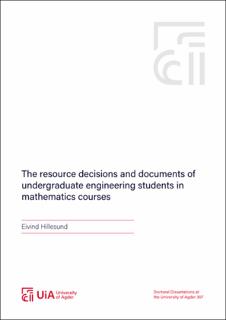| dc.contributor.advisor | Monaghan, John David | |
| dc.contributor.advisor | Hadjerrouit, Said | |
| dc.contributor.author | Hillesund, Eivind Rudjord | |
| dc.date.accessioned | 2021-01-12T08:24:51Z | |
| dc.date.available | 2021-01-12T08:24:51Z | |
| dc.date.created | 2021-01-04T11:49:02Z | |
| dc.date.issued | 2020 | |
| dc.identifier.citation | Hillesund, E. R. (2020). The resource decisions and documents of undergraduate engineering students in mathematics courses (Doctoral thesis). University of Agder, Kristiansand. | en_US |
| dc.identifier.isbn | 978-82-8427-010-4 | |
| dc.identifier.issn | 1504-9272 | |
| dc.identifier.uri | https://hdl.handle.net/11250/2722455 | |
| dc.description.abstract | This thesis concerns a multiple case study, carried out at three Norwegian universities. The goal was to find similarities and differences between how engineering students from different university contexts used resources to learn mathematics, and how they made decisions regarding their use of resources. My project had an inductive focus, networking thematic analysis (Braun & Clarke, 2006) with the theoretical framework of the documentational approach to didactics (Gueudet & Trouche, 2009). After my analysis, I also compared my results and conclusions to those of authors who have conducted research projects with a similar focus (i.e. Anastasikis, 2018; Gueudet & Pepin, 2016; Kanwal, 2018; Pepin & Kock, 2019). I generally found that my results were consistent with their reflections, but I had also identified trends that went beyond the ideas within the field.
Given the wide focus of the project, the result are numerous, and vary greatly in generality and theoretic value. There are two overarching results that I consider particularly significant to the field of research:
I identify an overall structure to students’ decision regarding resources. Students almost exclusively consider resources that are emphasized within the course at hand; that they are familiar with from previous educational experiences or that they are familiar with from non-mathematical activities (for instance YouTube and Google). They primarily make their decisions based on what seems suitable for the task at hand, with preference as a secondary concern. Examinations have a significant impact on what they consider suitable. Their preference for resources are based on quality criteria such as simplicity and that they are able to use the resources efficiently.
I introduce the notion of didactical resource purposes. Students use resources for the four purposes of introduction, practice, evaluation and explanation. That is, they use resources to learn the theory and foundations of a topic; to gain experience working mathematically within the confines of the topic; to evaluate their answers, their learning process or their understanding of the topic and to actively search for information when they realize that there is a fact that they do not recall or an aspect of the topic that they do not understand well enough to accomplish their goals. | en_US |
| dc.language.iso | eng | en_US |
| dc.publisher | 07 Media | en_US |
| dc.relation.ispartofseries | Doctoral Dissertations at the University of Agder; no. 307 | |
| dc.title | The resource decisions and documents of undergraduate engineering students in mathematics courses | en_US |
| dc.type | Doctoral thesis | en_US |
| dc.description.version | publishedVersion | en_US |
| dc.rights.holder | © 2020 Eivind Rudjord Hillesund | en_US |
| dc.subject.nsi | VDP::Matematikk og Naturvitenskap: 400::Matematikk: 410 | en_US |
| dc.source.pagenumber | 442 | en_US |
| dc.identifier.cristin | 1864701 | |
